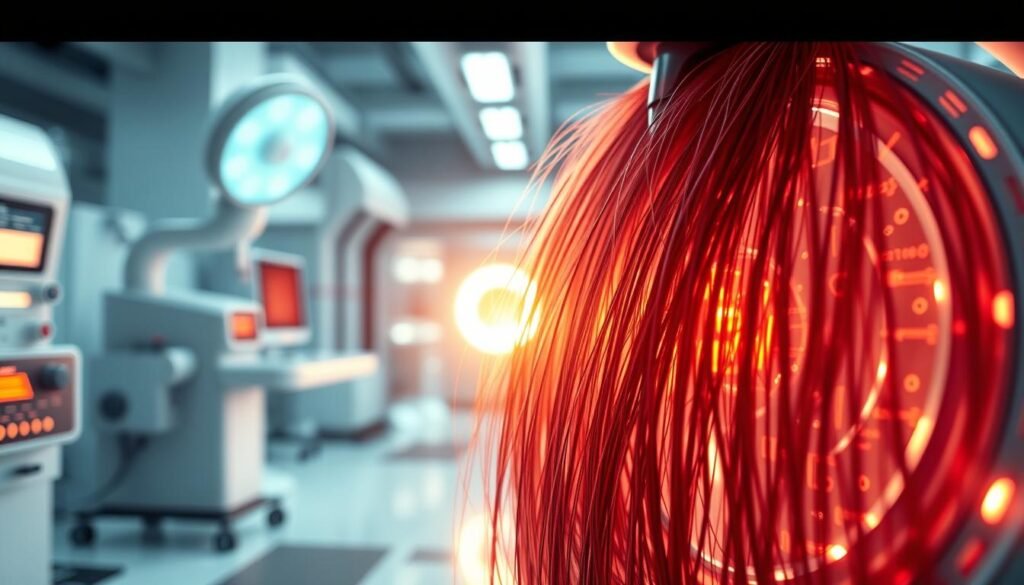Did you know about 6.8 million people in the United States have alopecia? This is an autoimmune disorder that causes hair to fall out. It shows we need good hair loss solutions now. As studies move forward, we see big changes in alopecia treatment. Thanks to better tech and understanding of hair loss biology, patients have new options.
New treatments are coming out, like discovering signaling molecules and approving new drugs. These steps make treatments work better and are less harsh. For example, Auxo Hair’s innovative treatments use the latest tech. This helps people feel better about themselves and live better lives.
This article talks more about the latest cutting-edge therapies. You’ll learn not just about scientific progress but also how these new treatments can help emotionally and mentally.
Key Takeaways
- Alopecia affects approximately 6.8 million people in the U.S.
- Innovative treatments are reshaping hair loss solutions.
- New discoveries, like signaling molecules, hold promising potential.
- Advanced technologies improve therapy effectiveness.
- Emotional and psychological benefits accompany new therapies.
Introduction to Alopecia
Alopecia is a term for different hair loss conditions affecting all ages and genders. The alopecia overview includes alopecia areata, androgenetic alopecia, and alopecia totalis. Each has unique features and effects.
Alopecia areata is an autoimmune disease causing patchy hair loss. This can quickly change how a person sees themselves. Androgenetic alopecia is also known as pattern baldness. It happens slowly and is often genetic. Alopecia totalis causes total scalp hair loss, deeply affecting confidence and emotions.
Lots of people in the U.S. experience these hair loss conditions. They hit children, teens, and adults, bringing emotional and mental hurdles. It’s crucial to understand hair loss. This helps everyone be more empathetic and supportive towards those affected.
Research underlines the need for awareness about alopecia. Discussing it helps people find support and look into treatments. This can make society more accepting and reduce the stigma around hair loss.
Understanding Different Types of Alopecia
Alopecia covers a variety of hair loss conditions. The main types are Alopecia Areata and androgenetic alopecia. Each has unique signs and reasons behind it.
Alopecia Areata shows up as sudden, spot baldness. It’s an autoimmune condition where the body attacks its hair roots. This can lead to bald spots anywhere, affecting any age or gender, but it’s usually seen in younger people.
On the other hand, androgenetic alopecia is known as pattern baldness. It’s due to genes and hormone shifts. This type slowly thins the hair, mainly on the top of the head. Men might see their hairline going back, while women often find their hair thinning on top.
Knowing the differences in Alopecia types is key to finding the right treatment. With correct diagnosis, people can find ways to improve their hair’s health.
| Type of Alopecia | Characteristics | Demographics |
|---|---|---|
| Alopecia Areata | Patchy hair loss, autoimmune response | Occurs in all ages, common in children and young adults |
| Androgenetic Alopecia | Gradual thinning, genetic and hormonal factors | Typically observed in adults, varies between sexes |
Causes and Triggers of Alopecia
Alopecia is caused by many factors and comes in different types. Knowing the Causes of Alopecia is crucial. Genes are often to blame, as a family history of hair loss can increase your risk.
Stress plays a big role too. It can be from tough emotions or physical issues. This stress can cause inflammation, making hair fall out in patches or get thin.
Autoimmune diseases are another key cause. With conditions like alopecia areata, the body attacks its hair follicles. This leads to quick hair loss. Hormonal shifts during puberty, pregnancy, or menopause also impact hair health.
Things around us can affect hair too. Pollution, harsh hair products, and too much sun can harm hair growth. Not eating well can also lead to hair loss, especially if you lack iron, zinc, and vitamins.
To wrap up, hair loss can come from genes, hormones, the environment, and diet. Understanding these Hair Loss Factors is the first step to finding better treatments.
Evaluating Traditional Treatments for Hair Loss
People have always relied on traditional treatments to bring back lost hair. Minoxidil and finasteride are top choices as effective solutions. However, the Limitations of Conventional Therapy are clear. Not everyone gets the results they hope for, and some might face side effects. This leads to mixed feelings among patients.
Limitations of Conventional Methods
The effectiveness of these treatments can vary greatly. For some hair loss types, they may not work as expected. The main challenges include:
- Variable efficacy: Minoxidil or finasteride don’t work for everyone.
- Side effects: Some might experience scalp irritation, unwanted facial hair, or sexual issues.
- Time-consuming: It can take months to see results, which can be discouraging.
For more details on how hair loss treatments are evaluated, check out this article. It offers a thorough review of various assessment methods.
Patient Experiences and Testimonials
Listening to people’s stories gives us more insight into these treatments. Many share inspiring stories of hair regrowth and regained confidence. Yet, some talk about their disappointment due to little to no improvement. And quite a few look for new treatments after traditional methods didn’t meet their expectations.
These stories make it clear how traditional treatments affect people. They show why we need more research into better solutions for hair loss.

Cutting-Edge Therapies for Alopecia
The field of alopecia treatment is growing fast. New therapies tap into the body’s healing to spur hair growth. These treatments, like gene therapy and advanced immunotherapy, tackle hair loss’s root causes.
Overview of Innovative Approaches
Cutting-edge treatments stand out from the old ways. They work with the body’s immune system or change how cells behave to stop hair loss. The aim is to both stop hair loss and regrow hair. Early studies are showing bold promises for these new methods.
Success Rates and Clinical Trials
Latest clinical trials shed light on how well these new treatments work. Success varies by treatment and who’s getting it. Trials show hopeful outcomes, sparking more exploration in this field.
| Treatment Type | Participant Demographics | Success Rate (%) | Study Phase |
|---|---|---|---|
| Gene Therapy | Adults aged 18-45 | 75% | Phase II |
| Immunotherapy | Adults aged 25-60 | 68% | Phase III |
| Platelet-Rich Plasma | Adults aged 30-50 | 80% | Phase I |
Advanced Healthcare Solutions: Stem Cell Therapy
Stem Cell Therapy is a cutting-edge method in hair rejuvenation. It uses the body’s healing power to boost hair growth. It’s a hopeful option for people with hair loss. Let’s dive into the Mechanism of Action behind this exciting treatment.
Mechanism of Action
The key to Stem Cell Therapy is how stem cells turn into hair cells. These cells are vital for growing and restoring hair. Injected stem cells help the scalp by increasing blood flow and nutrients to hair roots. This promotes a better setting for hair to grow.
Real-World Applications and Case Studies
Many real-world examples show Stem Cell Therapy’s success in fighting alopecia. Case studies reveal impressive hair recovery in patients who tried this new therapy. These stories suggest stem cell methods might be key in Innovative Hair Treatments.

| Case Study | Patient Age | Duration of Alopecia | Results |
|---|---|---|---|
| Case 1 | 30 | 5 years | Significant hair density improvement |
| Case 2 | 45 | 10 years | Partial regrowth of hair |
| Case 3 | 28 | 3 years | Total hair restoration |
Pioneering Medical Technologies: Platelet-Rich Plasma (PRP) Treatment
Platelet-Rich Plasma (PRP) treatment stands out in hair restoration techniques. It uses the body’s own healing power to aid hair growth. A simple blood draw starts the process, then plasma is enriched to create a powerful source of growth factors.
The enriched plasma is injected into the scalp, aiming at areas with less hair. This process wakes up the hair follicles, improving their performance. PRP treatment is less invasive than surgery, using the body’s own materials for healing.
Studies show PRP not only boosts healing but also improves hair thickness. It’s great for many people, offering a strong solution without a long recovery time.
PRP treatment’s growing fame comes from its proven results. Top dermatology journals have shown its high success rates. Thus, many view PRP as a breakthrough in hair restoration.
| PRP Treatment Process | Benefits | Considerations |
|---|---|---|
| 1. Blood Draw | Natural components promote healing | Results can vary by individual |
| 2. Plasma Separation | Minimally invasive procedure | Multiple sessions may be needed |
| 3. Injection into Scalp | Stimulates follicle activation | Not suitable for everyone |
Next-Generation Therapies: Topical Treatments and Solutions
The world of hair restoration is changing. New Topical Treatments are coming into play. These use advanced Hair Loss Ingredients. They are more effective and safer for users. As research goes on, the promise of these solutions gets even bigger.
Active Ingredients to Watch For
Some active ingredients are making waves in stopping hair loss. Here are the key ones:
- Minoxidil: This is a common choice for its ability to boost blood flow to hair follicles.
- Finasteride: Known for pills before, it’s now in topical forms to lessen side effects.
- Botanicals: Plants like saw palmetto and ginseng might block DHT, a hair loss culprit.
- Peptides: These small proteins are looking promising for hair regeneration and strengthening.
Effectiveness and Safety Profiles
Evaluating these new solutions is key. Many show good results in trials, but we can’t ignore the side effects. Some common issues are:
- Scalp irritation or itching
- Unwanted facial hair growth in women
- Increased hair shedding at the start
Teaching people about these products is vital. Knowing how they work and when to expect results helps set the right expectations.

| Ingredient | Type | Primary Benefit | Potential Side Effects |
|---|---|---|---|
| Minoxidil | Topical | Enhances hair growth | Itching, redness |
| Finasteride | Topical | Reduces DHT levels | Hormonal changes |
| Botanicals | Natural | Inhibits hair loss | Allergic reactions |
| Peptides | Synthetic | Strengthens hair | Minimal side effects |
Revolutionary Treatment Methods: Combination Therapies
Combination Therapies are a new hope in treating hair loss. They use different methods together for better results. People looking for hair restoration find these therapies appealing.
These therapies work by using multiple treatments at once. For example, they might mix creams with pills or try Platelet-Rich Plasma (PRP) therapy. This leads to thicker hair and happier patients. Studies show that using various approaches together works better than one method alone.
These innovative treatments mix old and new technologies. Clinical trials prove they not only fight hair loss but also its root causes. A research review shows understanding and treating all aspects boosts success.
Every patient gets a therapy plan made just for them. It’s based on their hair loss type and health. This personalized care makes patients feel more involved and satisfied with their treatments. It shows how important diverse therapies are for better outcomes.
State-of-the-Art Medical Interventions: Laser Therapy
Laser Therapy stands out in treating hair loss today. It uses Hair Growth Lasers for low-level laser therapy (LLLT). This helps wake up hair follicles, boosting hair growth. The technology boosts cells near the follicle, hoping to thicken hair.
How Laser Therapy Works
It starts by applying special light waves to the scalp. These waves go deep, energizing follicle cells. This boost in cell energy improves blood flow, important for healthy hair. With time, this can lead to thicker, fuller hair thanks to the treatment.
Benefits and Limitations
Laser Therapy has many positives as a way to get hair back. It’s not surgical, so it’s less scary for patients. People find it comfortable and a good alternative. Studies show it might really help grow hair again.
But, it’s not perfect. Treatments can get expensive, and not everyone will see the same results. You’ll need to stick with it for weeks, or even months. Researchers are still working out how best to use this technology.
Breakthrough Medical Advances: Investigational Drugs
In the area of Hair Loss Research, new drugs are making a difference. These treatments are creating hope by attacking the root causes of hair loss. They are based on the latest science, and clinical trials are testing their effectiveness and safety.
Today’s trials include several promising drugs. Each one works in a special way to improve hair health and growth. These investigational drugs not only stop hair loss but also help grow new hair.
Here’s some information on investigational drugs being studied for alopecia:
| Drug Name | Mechanism of Action | Status | Phase of Clinical Trials |
|---|---|---|---|
| Drug A | Inhibits inflammatory pathways | Promising results | Phase II |
| Drug B | Stimulates hair follicle growth | Under observation | Phase III |
| Drug C | Modulates immune response | Early stages | Phase I |
This table shows the unique features of drugs under research. There’s a new focus on better, specific treatments in Hair Loss Research. This progress means hope for researchers and patients. For more on these developments, see: latest insights on investigational drugs.
Conclusion
Exploring alopecia treatments shows us that hair restoration’s future is bright. New therapies like stem cell treatment, PRP, and combination therapies are changing how we tackle hair loss. Thanks to ongoing progress in medical technology, people have various choices that meet their needs.
Sources such as the Journal of Clinical Dermatology and Future Dermatology show how important it is to stay updated on new therapies. A personal touch in hair restoration not only works better but also creates a caring space for those with alopecia. This journey of finding oneself again and rebuilding confidence is full of possibilities for everyone.
The search for alopecia solutions is always moving forward. As more treatments come out, there’s more hope for better results and happier patients. Welcoming these new methods is a big step in dealing with hair loss. By focusing on personalized care, getting back to healthy hair becomes a reality for everyone.